Introduction
The following pages do not contain the whole of the tale. You must have a copy
of the Mabinogi (unabridged if possible, but it does
not matter which version) and any modern Ordnance Survey
maps of the areas under consideration. But remember
that the book was originally written in Middle Welsh,
so the spellings are likely to vary between each
version
according to the editor's choice.
These stories are rooted
in myths concerning the Celtic gods that have their
origins in prehistory. After the coming of Christianity,
the characters lost their divine status but the storytellers
described them as larger than life heroes from a time
long gone. These traditional tales were probably written
down in books for the first time in the Middle Ages,
more than likely by monks.
Professional story-tellers
were highly esteemed in mediaeval society, as the stories
themselves show. But they were neither historians nor
archaeologists, so they could not know what modern
investigations reveal about megaliths, cromlechs and
huge earthworks etc. For them, such sites were seen
as evidence of the work of their mighty ancestors.
Therefore is not surprising that they would try to
identify these places with these people and their deeds.
Also, curious place-names
were used to locate events, sometimes by very tenuous
connections. This type of legend is termed onomastic
– sometimes the connection (and the philology!) is
very suspect. Undoubtedly, over the millennia, the
deeds described in the Mabinogi were located in many
different places
between the Nantlle Valley and India by the Ancient
Celts.
Old Divisions and Hundreds (Cantrefi) of Wales
GWYNEDD – divided into two parts, Gwynedd Uwch Conwy and Gwynedd Îs Conwy.
POWYS - divided into two
parts, Powys Fadog and Powys Wenwynwyn.
DEHEUBARTH – the six southern
areas - Brycheiniog, Ceredigion, Dyfed, Morgannwg (including
Gwent), Rhwng Gwy a Hafren, Ystrad Tywy.
Pryderi's Kingdom was:
DYFED - 7 Cantrefs (Hundreds)
MORGANNWG - 7 Cantrefs
CEREDIGIAWN - 4 Cantrefs
YSTRAD TYWI -
3 Cantrefs.
Math's Court
DOL BEBIN in Arfon o.s 493525. The dwelling of Pebin, father of Goewin, the most
beautiful girl known there in that age. A housing estate
stands there now.
Where
was Caer Dathyl?
Unknown say the majority of our most eminent historians and men of letters during
the last two centuries. This question has caused some
problems; the name has not survived anywhere. Caer
Dathyl is mentioned more times than any other in the
Fourth Branch of the Mabinogi.
It is, perhaps, possible to imagine where Caer Dathyl was in the thoughts of
the storytellers:
1. To Sir Mortimer Wheeler,
the famous archaeologist, Caernarfon o.s. 476626 was
the obvious place – but it is mentioned in the Second
Branch, therefore it is very unlikely;
2. According to W J Griffiths,
Pendinas o.s.550653 near Llanddeiniolen was the right
place, not far from Creuwyon (Cororion), o.s. 597686
(but neither is this a believable location for the
pig sty [see below]). Both were in his
home district: surely a biased view!
Then is there somewhere
in the centre of the area, where the is a scarcity
of names that were directly mentioned in the Mabinogi,
(see map  ) with a 'neutral' name with no other significance
now? ) with a 'neutral' name with no other significance
now?
3. Bryn Hengaer o.s. 476526
(but also called Caer Engan - after the ancient king
and saint, Engan);
4. Craig y Dinas o.s.
447520 (note nearby are Lleuar Fawr o.s.445520 and
Lleuar Bach o.s. 448516 etc - names with a strong connection
with the tale).
But 3. and 4. are too
close to the River Llyfni; there is no mention of the
wizard Gwydion passing under the walls of Caer Dathyl
as he followed the sow from Pennardd, along the River
Llyfni to Nantlle, where he found Lleu in the form
of an eagle.
5. Y Foel o.s. 450507.
Many people have remarked on the noble and enchanting
presence of this hill, so visibly placed in the centre
of the district. On the top of Y Foel stands an Iron
Age fort. There are delightful views across the whole
area, and it is easy to imagine it as the stronghold
of the magician / king Math.
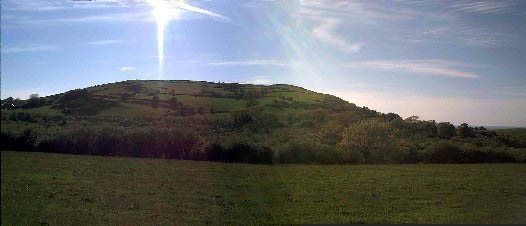
Image: Y
Foel / Caer Dathyl?
Who knows?
Provoking War
Annwn
The pigs were given to
Pryderi by the king of Annwn, the Other World of the
old stories - under the earth, they say. But according
to others, it is a world that exists side by side with
ours and also very much like it. But of course, not
everyone can see it!
(See the nantlle.com account of Martha of Mynydd Llanllyfni for related information.)
Stealing the Pigs
RHUDDLAN TEIFI, CEREDIGIAWN -
o.s.492431 map146 - Pryderi's court, near Lampeter.
This is an onomastic tale, that is to say - In this example, four local place
names that contain the word Moch (pigs), asserting
that the names have their origins in these incidents.
Night 1: MOCHDREF Uplands
of Ceredigiawn. (Nant y Moch?) o.s. 750850 (see also
www.aberarchsoc.org.uk  ); );
Night 2: MOCHDREF over
Elenid, between Ceri and Arwystli. SO0723988673 4 miles
to the southwest of Newtown, Powys
Night 3: Commote of MOCHNANT in Powys SJ125259
Night 4: MOCHDREF in the
Cantref of Rhos o.s.870780 near Colwyn Bay.
Night 5: CREUWYON (Cororion),
o.s. 597686 the highest township of Arllechwedd, where
a sty was made for the pigs. Then on to CAER DATHYL;
described as being in the cantref below the sty (but
some would maintain that somewhere like Tre'r Ceiri
would be more likely to fire the imagination of the
old story tellers as a location for the sty, and this
would be behind Math's host rather the in front of
it.)
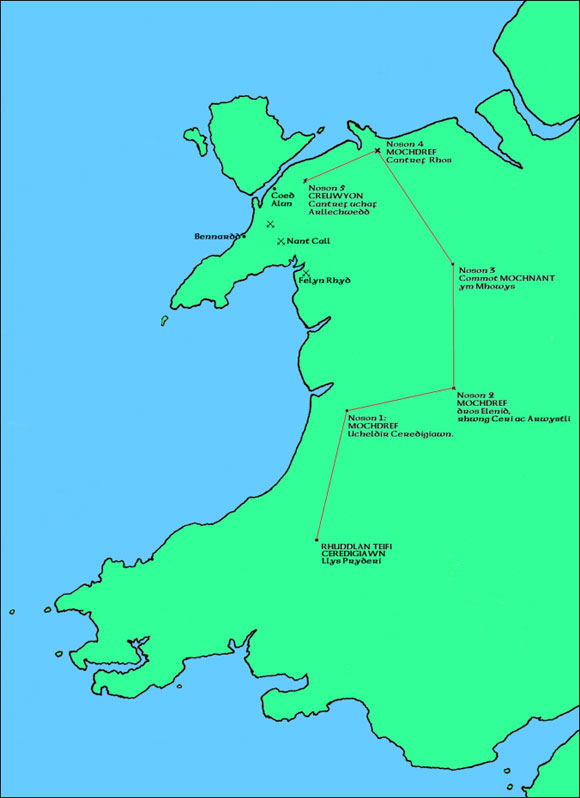
Image: The
journey of stealing the pigs.
Therefore Pryderi's army
came towards Caer Dathyl from the north as they followed
the thieves Gilfaethwy, Gwydion and their accomplices.
War
PENNARDD o.s. 430510 - Near the cromlech where Math's army waited. (That night
Gilfaethwy went to Caer Dathyl, were, with Gwydion's
collusion, he raped Goewin. Then he returned to the
army.)
The two armies faced each
half way between MAENAWR BENNARD o.s
426510 and MAENAWR COED ALUN (Coed Helen) o.s. 473622.
Perhaps the battle began
on what is now the Glynllifon estate. Did the storytellers
see the standing stone (o.s.445543) as some sort of
memorial?
BRYN GWYDION o.s. 444533 -
According to local tradition, Gwydion stood here to
watch and direct the battle.
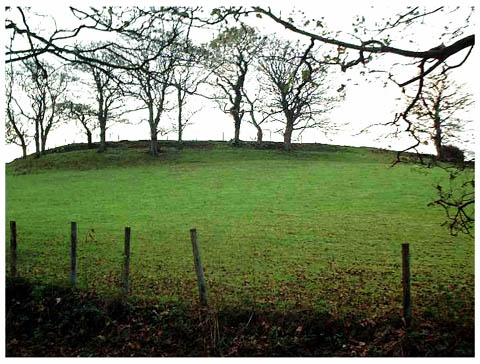
Image: Bryn
Gwydion.
Thence Pryderi's army
retreated to the south rather than following the
same
road home. Pryderi's army retreated
to NANT CALL / NANTCYLL o.s. 474470
where there was great slaughter.
Retreat to DOLBENMAEN o.s. 430506 – hostages were given.
TRAETH MAWR o.s.590400
- There the fighting recommenced. It was a very different
place in the Middle Ages. The water reached as far
as Aberglaslyn, Penmorfa and Llanfrothen. In the middle
of it there were a number of small islands. Gerald
of Wales and his fellow travellers crossed it by boat
in 1188, some two centuries before the Mabinogi was
written down. (The Cob was built in Porthmadog in 1811
as part of the scheme to drain the land.)
Y FELYNRHYD o.s. 648397
- where Pryderi was killed below (downstream
from) MAEN
TYRIAWG (Maentwrog) o.s. 655405 - where
Pryderi was buried.
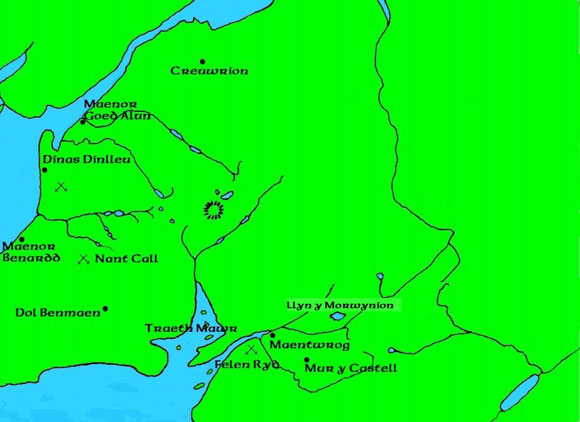
Image: Y
Felyn Rhyd.
Thence to CAER DATHYL.
Gwydion and Gilfaethwy's punishment
Having behaved worse than animals, Gwydion and Gilfaethwy were transformed into
deer, wild boar and wolves for a period of three years
by Math.
The wooded environment
of the Middle Ages would be far more favourable to
that sort of animal than the present landscape.
No other specific place
is mentioned except Caer Dathyl.
The story of Dylan
MAEN DYLAN o.s. 426525
BEDD DYLAN o.s. 407495
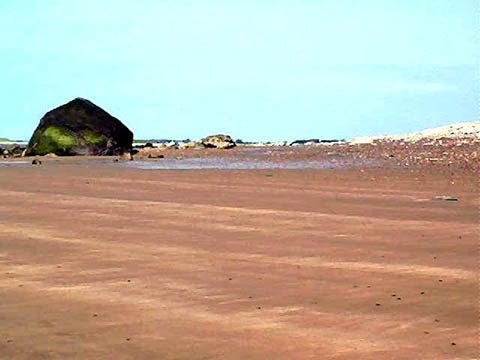
Image: Maen
Dylan.
Neither of these places
is mentioned by name in this story, but in Englynion
y Beddau, it is said that Dylan was buried in Clynnog
- this story is incomplete in the Mabinogi. Despite
some references in some other ancient fragments, it
would be impossible to recreate this tale fully.
According to Marwnad Dylan
Eil Ton (Elegy for Dylan Eil Ton) by Taliesin, Gofannon
was a smith and his nephew Dylan was his assistant.
A trident was made in the forge which was used by Gofannon
to kill Dylan.
Smiths were considered
to be magicians of old. Is there a connection with
the following names:
CAERGOFAINT o.s. 444529;
CAE'RGOFAINT
BACH o.s. 442532?
Visiting Caer Arianrhod
Incredible journeys! This is another example of the storyteller pulling the listener's
leg!
1. Walked to CAER ARANRHOD (Caer Arianrhod o.s 423547): then to Caer
Dathyl. The next morning they walked to ABERMENAI o.s.
440610.
2. By magic boat. The boat
disappeared, so they left by some other means. "They came towards DINAS DINLLE" o.s. 437564 This is not the only "City of Lleu" in Western Europe - Lyon and
Laon in France, Leyden in the Netherlands and others
are all named after Lleu / Lugh / Lugus, the Celtic
Sun God. (This is the only mention of the hill fort
by the sea. One explanation of the name's significance
is that Lleu was brought up there. See below: A Different
Ending?)
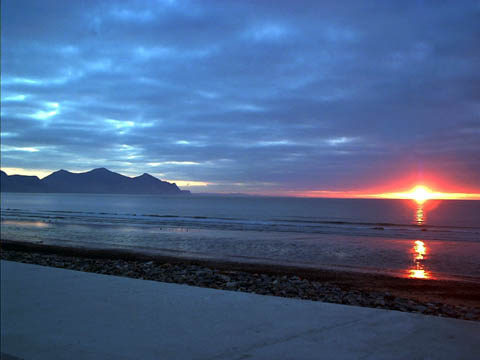
Image: The
view out to sea from Dinas Dinlle.
3. They took the seashore
up towards BRYN ARIEN (Brynaerau o.s.440522),
then at the top of CEFYN CLUN TYNO (Cefn Clydno) (Fferm
Coedtyno nr
Capel Uchaf o.s.431500) – and then on horseback to
CAER ARANRHOD.
According to local people,
in a completely different story, "Trearanrhag" was
drowned because of the people's sins; only three women
survived. Some say that the name Caer Arianrhod refers
to the submerged reef. But according to others, we
should
look to the skies, the Milky Way is called by that
name. But it is also said that the Corona Borealis
is also named Caer Arianrhod...
Blodeuwedd
CANTREF DINODING, later
divided into Eifionydd (EIFYNYDD) and Ardudwy.
MUR (Y) CASTELL (TOMEN Y MUR) o.s. 705387 A Norman castle built on the site of
a Roman fort, in upland Ardudwy.
PENLLYN - district above
Llyn Tegid
CYNFAEL - a river, near
Llanffestiniog.
BRYN CYFEGYR - hill on
the bank of the Cynfael . Now called Bryn Cyfergyr
where Gronw Pebr stood to throw his spear at Lleu.
NANT LLEU – Where a tree
stood (an oak, some say) between the 2 lakes (Baladeulyn
o.s. 509534) or on an upland plain or on a steep slope.
It is not totally clear where the tree was – the storyteller
leg-pulling again, perhaps?
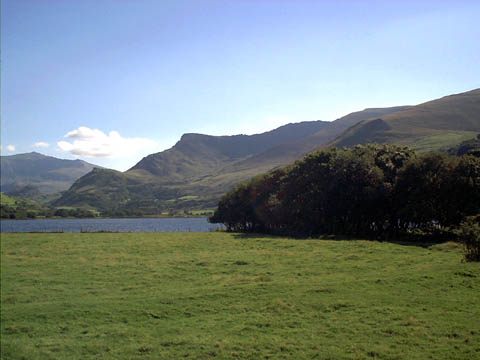
Image: Between
the two lakes.
LLYN Y MORWYNION o.s.
737423 - (a place not mentioned directly by name in the Mabinogi.
LLECH RONW – on the banks
of the River CYNFAEL.
A standing stone, now fallen, on the banks of the river
near Llety Nest next to the new bridge. They say that
a hole was made in the stone by Lleu's spear when he
killed Gronw Pebr.
(The "exchange of blows"
is a common theme in similar legends – Lleu had been
struck once, therefore he had the right to strike his
attacker once also.
A Different Ending?
It is possible that every storyteller had his own unique version of each part
of the story; only the familiar tale in the Fourth
Branch, written down in the Middle Ages, is known to
us.
But some say that MUR
Y CASTELL in ARDUDWY was not the home of Lleu and Blodeuwedd,
but rather DINAS DINLLE in ARFON.
CAER LODA o.s. 438548
1. Lleu was dismembered
nearby at Caer Loda that is The Field of the Limbs.
Although there is no mention of him being dismembered
in the Mabinogi, bear in mind other myths – i.e. Egypt
– Isis and Osiris: a goddess was killed by her enemies,
and another god collected all the pieces which were
scattered all over the world and then brought her to
life again. In Ancient Greece the story of
Adonis… etc.
2. Or his arms were transformed:
Aelodau was the mediaeval hawking term
for the wings.
So, according to this
dubious theory, Lleu was found by Gwydion in the Nantlle
Valley, comparatively close to the place where he was
wounded by Gronw's enchanted spear.
IMPORTANT DISCLAIMER: THIS LOCALITY INFORMATION IS FOR REFERENCE PURPOSES ONLY.
UNLESS THERE IS A PUBLIC RIGHT OF WAY, YOU SHOULD NOT
ATTEMPT TO VISIT ANY SITES LISTED WITHOUT THE PERMISSION
OF THE LAND HOLDERS.
|